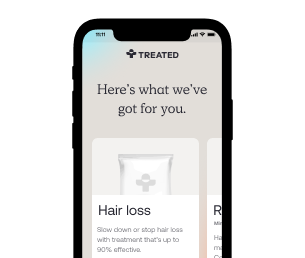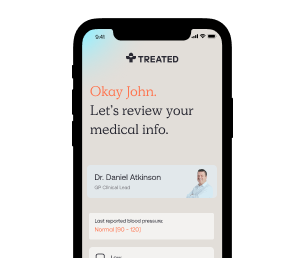Actinic keratosis
Creams to ease sun-related blemishes.
Actinic keratoses are dry, scaly patches that appear on your skin because of sun damage.
Although they might not give you any symptoms, there’s a small chance they can lead to other problems. Order actinic keratosis treatment online and get expert advice from our clinicians.
Actinic keratosis, also known as solar keratosis, is a dry, scaly patch that appears on your skin after prolonged exposure to the sun.
Actinic keratosis can be a precursor to skin cancer. So if you have one or more of these patches on your skin, it's recommended that you get it checked out by a clinician so that they can check that it’s nothing serious.
If you just have one patch then a clinician might recommend waiting to see if the patch goes away by itself. But if you have multiple patches, or if it’s causing you discomfort or pain, then you’ll probably be recommended treatment.
Actinic keratosis usually occurs in people over the age of forty, but on rare occasions it can appear in people younger (if they live in places with high UV exposure all year round).
You’re more likely to develop actinic keratosis if you have fair skin, blonde or red hair and blue or light-coloured eyes. If you have or have had a job that requires you to work outside for long periods of time then this can make you more likely to develop actinic keratosis as well.
It’s a common condition, but it’s more frequently seen in some parts of the world than others. It’s most commonly seen in countries with a lot of direct sunlight, where there is a large number of fair-skinned people. So Australia, for instance, is estimated to have the highest incidence of actinic keratosis, with over 40% of people over 40 said to have it. This stands in some contrast to the northern hemisphere, where estimates are between 11% and 25% amongst people aged 40 and above.

How we source info.
When we present you with stats, data, opinion or a consensus, we’ll tell you where this came from. And we’ll only present data as clinically reliable if it’s come from a reputable source, such as a state or government-funded health body, a peer-reviewed medical journal, or a recognised analytics or data body. Read more in our editorial policy.
Actinic keratosis is caused by prolonged exposure to UV light. So it’s not necessarily just sunlight that can trigger it; it can also be caused by spending too much time on sunbeds as well.
It’s important to note as well that UV light can affect your skin even on cloudy or cold days, and not just on hot, sunny days. If you wear sunscreen, try to stay in the shade when the sun is at its highest in the sky. You should also pay attention to the ‘UV index’ (taking extra precautions when the number is high) to reduce your chances of developing actinic keratosis.
Actinic keratosis appears as dry, scaly patches on your skin. They’re typically 1-2cm long, discoloured, and appear on parts of your body that are more commonly exposed to the sun, such as the back of your hands and lower arms, as well as your head, neck and face.
It’s unlikely, but actinic keratosis can become skin cancer. So it’s always good to keep an eye on your skin, and if any new or different looking patches appear, you should make an appointment with your clinician for an examination.

How we source info.
When we present you with stats, data, opinion or a consensus, we’ll tell you where this came from. And we’ll only present data as clinically reliable if it’s come from a reputable source, such as a state or government-funded health body, a peer-reviewed medical journal, or a recognised analytics or data body. Read more in our editorial policy.
In order to treat actinic keratosis, you’ll usually be prescribed a cream or gel which you’ll apply to the patch (or patches) to remove them. This is often the best option if you have several keratoses, or if many of them are difficult to see.
On some occasions, though, a clinician might recommend a clinical procedure which you won’t be able to perform yourself at home. This can include cryotherapy, where the keratoses are frozen and fall off after a few weeks, surgery to cut off the affected patches of skin under anaesthetic, or photodynamic therapy (PDT). PDT is a procedure that involves putting a light sensitive cream on the affected skin before pointing a special light at the keratoses, which will kill the abnormal skin cells.
The best treatment for actinic keratosis really depends on the nature of your condition, symptoms, and the advice of your clinician. If you just have one patch of affected skin then your clinician might just recommend keeping an eye on it to see if it goes away on its own. If you have a number of visible patches, a procedure to remove them may be recommended. Or if there are a number of patches that are difficult to see, then you’ll likely be given a cream or gel that you’ll have to apply to these patches at home over a number of weeks.
If you’ve noticed a patch of actinic keratosis for the first time then you should definitely seek the advice of a clinician. But if it’s just the one patch, and it’s not causing you any pain or discomfort, then it may go away on its own without treatment. You’ll be advised to avoid the sun where possible, wear sunscreen, cover your skin and avoid tanning beds in order to prevent any further sun damage.

How we source info.
When we present you with stats, data, opinion or a consensus, we’ll tell you where this came from. And we’ll only present data as clinically reliable if it’s come from a reputable source, such as a state or government-funded health body, a peer-reviewed medical journal, or a recognised analytics or data body. Read more in our editorial policy.
Have something specific you want to know? Search our info below, or ask our experts a question if you can’t find what you’re looking for.
Actinic Keratosis: Rationale and Management. Dermatology and Therapy, 4(1), pp.11–31.
[Actinic keratoses]. Hautarzt. Jun;54(6):551-60.

The go-to treatment for moderately thick actinic keratoses in adults with a healthy immune system.

5% Imiquimod cream for the topical treatment of actinic keratosis and pyogenic granuloma.

The only diclofenac gel specifically designed for actinic keratosis.

Registered with GMC (No. 4624794)
Meet Daniel
Registered with GPhC (No. 2202465)
Meet Sanjeda
Registered with GPhC (No. 2070724)
Meet Craig
Always read the leaflet that comes with your medication and tell us about any side effects you get.
We know health, but you know you.
Our experts tell you what’s safe, but you decide what’s best.
Answer a few questions and tell us about yourself. Get tailored advice from our clinicians so you can choose better.

Choose your treatment and how often you have it delivered.

We know things change. It’s the nature of life. We’ll check in regularly to make sure your treatment is still right for you.
Pause. Change. Skip. Start again. Any time you like.
Here are some other things we can help with.
Let’s make BPH treatment simpler. Get ongoing care from our clinicians, but without the hassle of appointments.
Tablets, creams, injections. Get expert advice and choose the ED treatment that’s best for your life.
Cream, tablets, spray. PE treatment is available. Our experts can support you to find the best solution for you.
We're making healthcare more about you. Sign up to our newsletter for personalised health articles that make a difference.
Disclaimer: The information provided on this page is not a substitute for professional medical advice, diagnosis, or treatment. If you have any questions or concerns about your health, please talk to a doctor.
We couldn't find what you're looking for.
Here's everything we treat. Or, if you're looking for something we don't have yet, you can suggest something.
If there’s a particular treatment or condition you’re looking for, tell us and we’ll look into it for you.
Submit your question here, or tell us if you’ve found an issue on our site.
We’ll get back to you very soon. We aim to respond to all queries in one working day.
You’re signed up to our newsletter. Keep an eye on your inbox for our latest update.
By clicking 'Subscribe now' you're agreeing to our Privacy Policy.
We’ve sent you an email asking you to confirm your email address.